The Popularity of Hair Dye

Part 1
DIY Self-Coloring 101: Make Your Customer Happy
Departing from the classical 1B that has dominated many retail shelves for a long time, hair and braids are coming out in varying colors such as rainbow and neon. Consumers are open to hair coloring and color waxes than ever and can easily try new hair colors for a change. Evolving hair color products are making hair color change quicker and effortless. A quick spraying or a quick application of a color wax can immediately bring out a new hair color. There are growing needs of consumers who want to express themselves with hair color. Let’s talk about how to boost your sales by getting familiar with hair color products that customers want.
When you go to a beauty supply retail store, you will easily find a variety of coloring products. Especially, on weekends and holidays, more than a usual number of customers shop for hair colors. Customer loyalty is high for hair colorants. If they do not find one they are looking for, they will walk away! Now we wonder how safely our customers are dyeing their hair.
Let’s find out (1) what tips you can give out to DIY customers, (2) how to categorize different types of colorants, (3) considerations before hair dyeing, and (4) how to keep the dyed hair healthy and its color vivid for a longer time.
As the age goes, colorants are changing. From the traditional powder types, you have liquid types and of course the most popular cream types. More recently, bubble types and gel type products are getting attention from the Generation Z. Customer satisfaction after coloring the hair should be able to boost human hair sales as well.
A. Dyeing – having desired color replace melanin pigments.
Hair consists of medulla core root at the center, a cortex surface taking 80-90% of the hair, and the outer surface made of solid keratin called cuticle.
The color of a hair is determined by the melanin pigments inside the cortex. Melanin pigments in hair can be either darker eumelanin and lighter phaeomelanin, they can manifest different colors brown/black and red/yellow, respectively. When these pigments disappear, the hair becomes white or silver in color. The amount of pigments in a hair varies for different people, which results in various hair colors for individuals.
The basic principal of hair coloring is getting rid of these melanin pigments and replace them with a new coloring agent. In technical terms, ammonia opens up the cuticle layer, peroxide bleaches out melanin pigments inside the cortex, and coloring agents in colorants replace the melanin pigments. After the colorants sit inside the hair, the cuticle layer should be closed again to be permanently dyed.
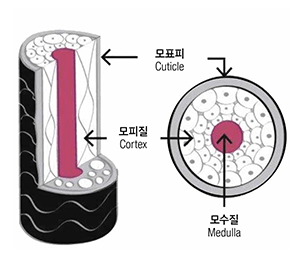
B. Colorants by How Long the Color Lasts
- Permanent Colorants
They are usually in a box package, and it is the most common kind. It brings about bleaching and coloring effects, so varying bleach levels and colors can bring about a wide range of colors. 100% gray hair cover-up products belong here. Generally, the mixture of coloring agents and alkaline agents (ammonia) and peroxides can be used to lighten the hair color or to change it.
Ammonia helps to open the cuticle and swell the hair shaft, so the coloring agents can easily penetrate the hair cortex. When the coloring agents sit within the keratin protein, the size of molecule prevents them from escaping easily. Thus, the permanent coloring lasts through multiple washing and rinsing. On the other hand, it can damage hair significantly and cause allergic reactions.
When you want to achieve a bright color, you need to repeat the bleaching step for two or three times. This prepares the hair for coloring into a desired color. If you have used relaxer recently, hair coloring should wait for about two weeks.

- Semi-permanent Colorants
Semi-permanent colorants create a thin layer over the hair after the coloring agents get into the hair, which enables the lasting color. Although it varies by individuals, one should expect to return to an original color by two to four weeks. Frequent shampoos should accelerate color fading. Often comes within a plastic bottle with acidic coloring agents, they cause minimal damages and allergic reactions. Nevertheless, a repeat use for an extended time could stiffen the hair. Also, the dye cannot be easily washed away from skin. It can be used even right after the application of relaxer.
DNA hair color products by Universal is a natural ingredient colorant infused with Henna Extract and shea butter. It includes no ammonia or bleach, and the creamy viscosity designed to work with a small amount is the selling point. The color agents penetrate deeply to the cuticles and provide an accurate color that lasts more than 21 days while maintaining a shiny and silky hair, beloved by customers.

- Temporary Colorants
Temporary colorants literally provide a temporary coloring with a color coat on the hair surface. The hair cortex and cuticle are not exposed to coloring agents, which frees you from side effects such as allergic reactions. Right before an going out, if you want a style change but have no time, you can simply spray or apply with hands to cover hair with varying colors.
The coloring agents can be washed away when exposed to water, so rain or sweat as well as a shampoo would wash the color away. Additionally, color spray or mousse can harden the hair that cannot be combed at all or without losing the coloring.
Many touch-up products belong to this category. Different application types are available including brush, spray, pen, and crayon. Especially, the color waxes in recent trend belong here as they can be easily applied to a desired area, providing an instant coloring effect. There are many gel type products that offer hassle free application.
You can also find cover-ups for hair loss that can be applied to the scalp. Dark colored hair powders that match the hair color are designed to provide extra volume. Various applicators such as a sponge with a handle or a stick with a felt tip are also available to satisfy a wide range of customers.

- Natural Ingredient Colorants
Made of herbal ingredients, plant-derived coloring agents can protect hair and scale while reducing allergic reactions.
Like oxidative colorants, it incorporates a two-step process and different coloring agents. Instead of alkaline colorants that is reported to have PPD-related side effects, a growing number of customers are looking for plant-based coloring products. Natural ingredient colorants usually last about three weeks, and they require a two-step process with a 10 to 20-minute rest between the steps. Indian tradition-inspired henna is a mixture of plant-based coloring agents that carry a similar pH with skin and hair at 5.5. Although it usually costs about 1.5-times compared to non-henna products, you may recommend them to customers who are concerned about sensitive skin and allergies.

C, How to Sell Colorants?
An owner/beautician at a beauty supply store in Virginia says, “you need to be really careful when a customer comes looking for a hair color product. People get different color results from a same product. How nice would it be if the color outcome is the same as the package label?” That tells the difficulty involving hair color sales.
A manager at a retail store in California points out that most complaints and returns come from customers who bought colorants. For example, “depending on individuals and their previous dye colors, the color outcome varies. Especially for women, menstrual cycles or varying health conditions affect the sensitivity to colorants to a great extent.” In addition, “you should always consult them to read the label and instruction on the package to avoid problems.” An important point when you deal with various colorants and picky customers.
- The Goal Is Getting a Desired Color
The basic goal of hair dye is to get a desired color. Many toxic chemicals such as ammonia and PPD are used for this purpose. These chemicals often sit on scalp including other skin areas, so the negative side effects are inevitable.
There is a distinctive odor when you open a colorant container. This odor can cause itchy eyes or headache to some individuals. The para-phenylenediamine (the PPD in short) is a chemical ingredient included in alkaline colorants. This chemical is also used in tattoos. As well as the garment dyeing. This PPD can bring about many negative side effects including itchy scalp, hair loss, skin discoloration and swelling.
An employee at the research and development division of a hair color company emphatically says, “if your colorants include toluene sulfonic, diamine, or aminophenol, you definitely want to do a patch test at least in 48-hour advance. A strict obeyance to instructions given by the manufacturers is also important. There are consumers who report a sudden allergic reaction, which is due to varying circumstances including health condition, hair care products they are using, and so on, which can result in adverse chemical reactions.”
That means you need to do a patch test even you have used the same product in the past. A patch test can be performed on an arm with a small amount of colorants to identify any allergic reactions.
Then, how can you prevent side effects? What can be done before dyeing your hair? How can you maintain the color longer? Are nutrient supplements, hair treatments or oil products good for dyed hair? Many questions from customers are answered here by professionals from beauty salons and hair color companies.
- Inform the Customer
From pre-dyeing to dyeing and post-dyeing care.
- Do not shampoo right before hair dyeing. A clean hair may be too smooth to attract coloring agents.
- A deep conditioning before coloring can strengthen the hair in preparation for upcoming exposure to strong chemicals. Deep conditioners can provide extra moisture to hair, which can help absorbing color. Stick to the package instructions. Conditioner should be completely rinsed off after leaving it for 5 to 30 minutes.
- Test before using colorants for allergies. The patch test can be easily done by applying it on inside surface of your arm with a cotton swab.
- Apply Vaseline or other creams on skin areas close to hair including behind ears and forehead to avoid skin discoloration. You can use makeup removers or nail polish removers if discoloration occurred.
- Different parts of a head can have different body temperature. Therefore, you might want to start with distant areas in the back and move on to sides, other parts and the hairline. The top of head has the highest body temperature, so you want to leave it for the last. Apply colorants to a small area at a time. If you apply too fast, your curl pattern can be interfered.
- Read the instructions on the side or back side of the package. You should remind the customers to read the labels before use.
- Wait for the color outcome. The product should be left for a time period suggested by the manufacturer. For a better result, you may want to wear a plastic shower cap.
- Before finishing dyeing process, you might want to apply deep conditioners or hair treatments often included in the hair color product package in order to reinforce the hair and add shine. A warm towel, shower cap or scarf can be worn for about fifteen minutes to protect hair.
- Thoroughly rinse the colorants with warm water till you notice no coloring agents left in hair, and then shampoo the hair.
Do not wash your hair with hot water. This may cause premature fading of color.
- You can recommend color-protect products including special shampoos, sprays, or creams.
PART 2
Let’s Sell Colors Fall 2019
This upcoming Fall and Winter 2019, what colors would be selling? We analyzed the consumer trend by looking at the google search statistics for the past year as well as trendy colors suggested by KISS and studying advertisements on BNB. Neon Green colors are certainly on a rising trend for this fall. Especially, the Past 3 months BNB advertisements from August to October is worth paying attention to the color trends of purple, blond and rainbows colors. Also, Blue, Green, Rose Gold were top contenders in the beauty industry trend. With colors, consumers are becoming more confident that they can fully express their individuality. understanding customer needs and knowing colors lead to increased sales in in the second half of 2019.
A. Popular Hair Colors by Google Trends
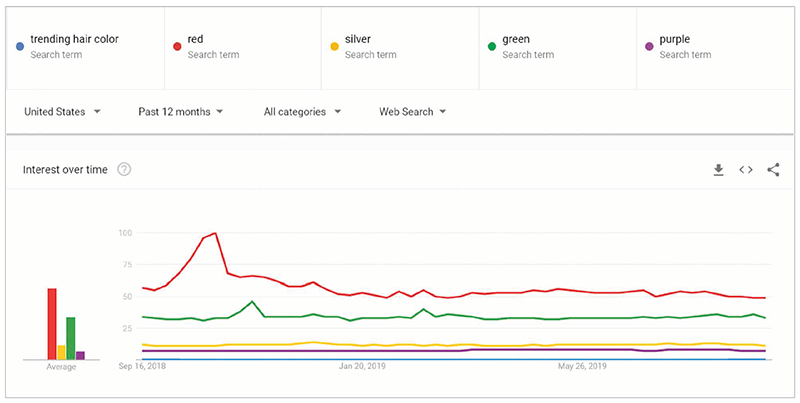
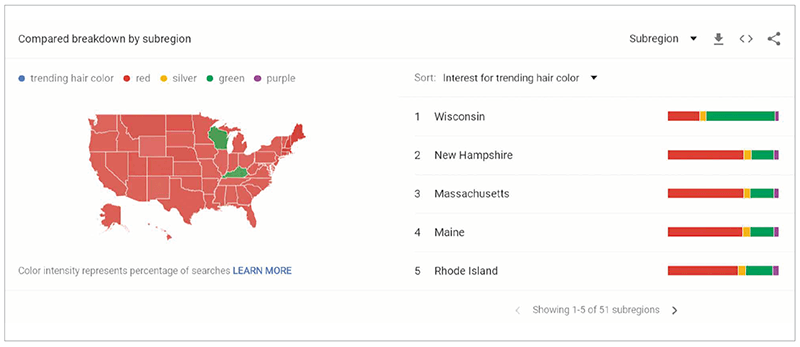
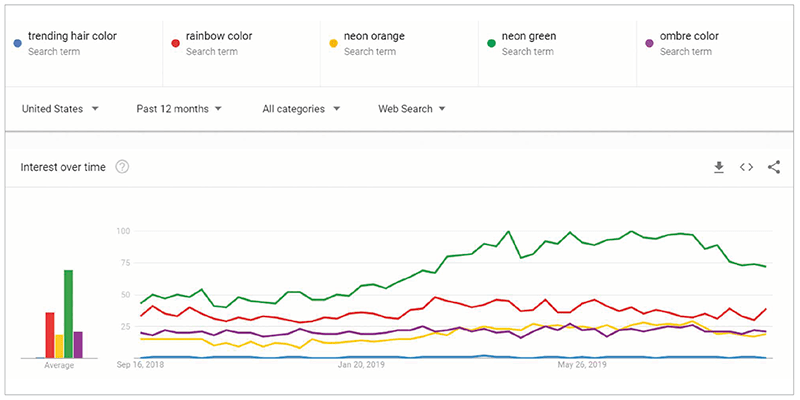
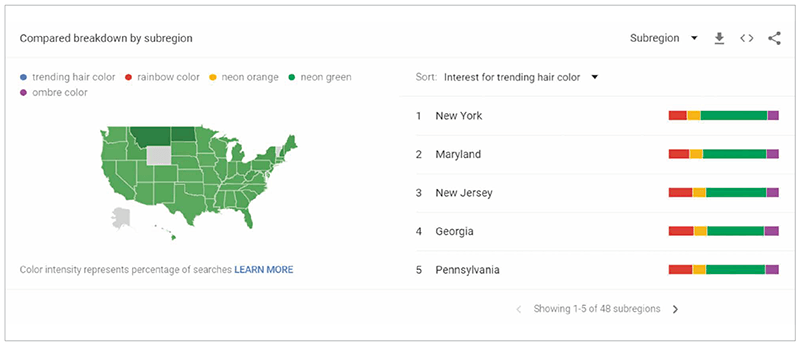
C. Hair Colors by BNB Advertisement
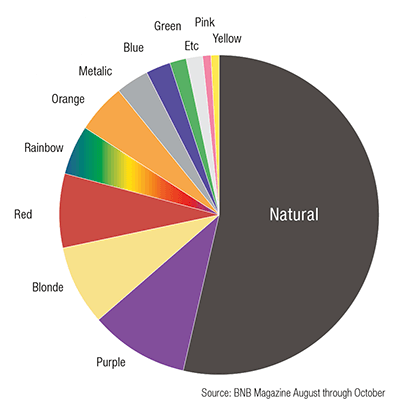
- Trendy Colors by KISS
Hair Color Division of KISS handpicked blue, lime green, rose gold, silver, crimson, cajun spice, and jet black colors for 2019.
★ Trendy Color
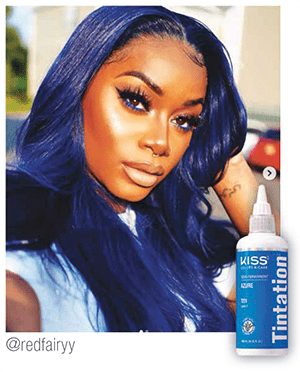
Blue: Steadily popular on Instagram, it’s bold and vivid. Blue Moonlight is the most popular color in the Tintation lineup.
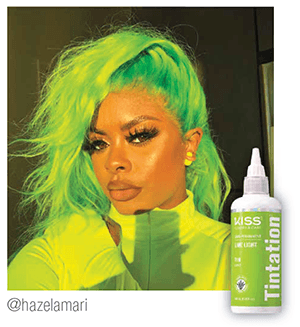
Lime Green: for an explorer of something new! Since SZA introduced a long length hair wig in lime green at the Flawless Experience last year, it has been catching consumers’ eyes.
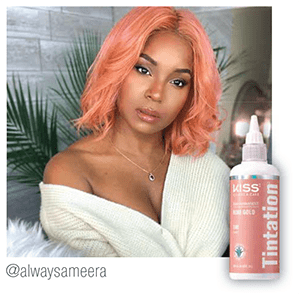
Rose Gold: At every Bronner Brothers International’s beauty show, rose gold color is the first to sell out. Its soft hue goes well with every skin tone, and the demand is high.
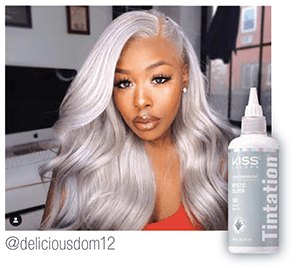
Silver: For the past years, silver became a mainstream color and is still a trend. Silver colors can be easily manipulated. For example, different silver colors of the Tintation line can be mixed and matched to the exact hue and tone customers desire.
* Tintation is a semi-permanent hair color treatment that brings vivid coloring to every corner of hair and mixable with a hair conditioner. Especially, the first ingredient aloe vera juice as well as argan oil, olive oil, collagen, and keratin bring numerous benefits to hair and scalp with no ammonia, no peroxide, and no sulfates.
★Classic Favorites
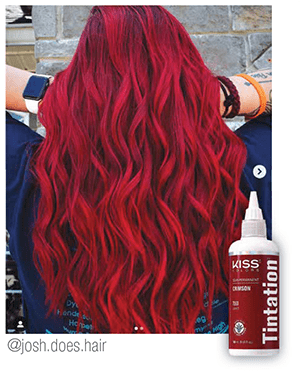
Crimson : This color withstands any trend and stays as a classic go to color for those who want to experiment with hair color. This vibrant statement color is one that will always be a popular choice in the hair color community.
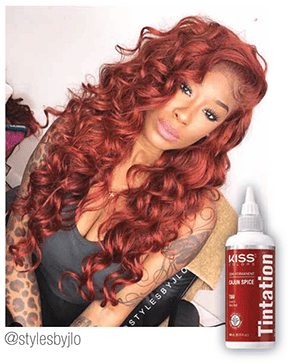
Cajun Spice : Cajun Spice hair color is the perfect color for those who want a slight pop of color without being too bold. and staying on the natural side. Cajun Spice is the perfect color for the upcoming fall and winter season.
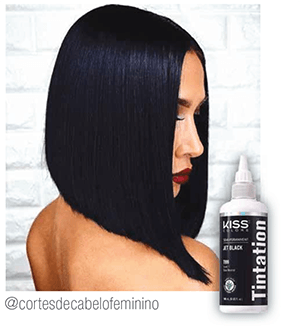
Jet Black : Jet Black is a staple color for every colorist out there. It is a basic color that can be used for many different purposes. It an be used to darken natural black hair, as a root color, mixed with other colors to darken them, and define and enhance
Part 3
Secrets to Sell Hair Color Products
“Usually, I would recommend human hair products suitable for coloring. For example, Brazilian or 613 hairs. You know they wouldn’t complain from experience”, said the owner of a retailer store in Florida. A retail store manager in Chicago frequently heard complaints from customers and learned that different brands bring different outcomes. Since then, she tried out hair color products herself, based on which she would recommend products.
“This bundle is labeled suitable for hair dyes. Is it for real?”
“Can this wig be dyed?” “Which coloring products are good?”; and “How long do I want to keep the coloring agent on my hair?”
These are some of most frequently asked questions. Some retail owners are regretful for missing many sales opportunities because they did not know how to answer customers’ questions about the coloring techniques and procedures. To redress this issue, we outlined a basic step-by-step guide and hair color essentials. Nevertheless, you should warn customers to always read and follow the manufacturer’s instruction as techniques and procedures should vary depending on the products.
HOT IDEA
- If you want to attract more young customers, display colorants in the front.
- Include additional products to cover gray hair and dye beards.
- Organize various products including colorants, color waxes, and color sprays in a neat and welcoming fashion. (Utilize display tops rather than putting them inside the display.)
- Place easy-to-dye bundle hairs close to hair color products.
A. Prepare a bundle, closure, or wig for coloring
Things you need: human hair, latex gloves, cosmetic thin foil, a mixing bowl, colorants, bleach powder, oxidants, and your coloring brush.
- Pre-coloring Care
You should use human hair for coloring. Remy hair or virgin hair are especially suitable for hair dyeing. Customers who do coloring on wigs for the first time are more likely to complain about the damages or poor coloring results after purchasing wigs not suitable for coloring. When a customer asks about coloring wigs, you should first ask if she has a wig suitable for coloring.
Rinse wigs with shampoo to remove all residues. Gently wash them with shampoo and warm water, and towel dry. To open the surface of hair and speed up the dying process, thorough washing is very important.
Before choosing a color, original hair colors must be considered. First, find out if you need bleaching. If you want a vivid color like blue or pink, you probably need to bleach hair multiple times. In case you want to dye hair into a darker color such as jet black, bleaching is not necessary.
- How to Bleach: Bleach & Developer
Mix bleach (peroxide powder) and developer 1: 1 in a mixing bowl. Mix them well using your coloring brush. (Mix only the amount needed for the work.)
Normally, bleach powder strength is marked by volume. 20 Vol. peroxide lifts brightness by two levels, 30 Vol. peroxide three levels, and so on. If you need a heavy bleaching, you might want to consider 40 Vol. peroxide. However, at 40 Vol. strength, peroxide can easily damage the hair, so caution is warranted.
On a foil, you apply the mixture on bundle or wig hair and then close them up with the foil. Wait for 15 minutes. Of course, the time can vary depending on the brand and volume of peroxide powder. You should always consult the manufacturer’s instruction.
Thoroughly wash the chemicals off the hair. See the result and repeat the process if you want a brighter color. You need to continuously check the color every five minutes or so. (Do not exceed 40 minutes maximum.)
- Rinse with water and dry the hair.
- Dye the hair.
Start with an inch overlap from the bleached area and apply colorants using your color brush.
The overlap is needed to create a natural progression of hair color from the original colored area to the bleached area. Cover it up with plastic wrap and let it stay for 30 minutes.
- Shampoo.
Wash the bundle or wig hair with shampoo and perform 15-minute deep conditioning. Wash deep conditioner off the hair and towel dry. Place the hair on a dry towel.
B. Get Pink or Green out of 613 Color Hair
A beauty supply retail store manager in New Jersey was asked by a customer: “How do I do water color?” To supply an answer, we want to introduce an idea from a Youtuber.
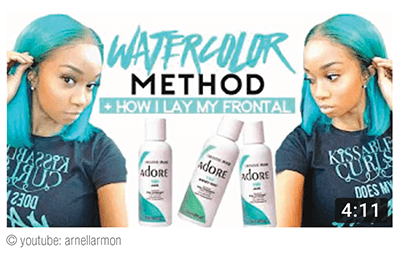
C. Kiss Color와 Adore 로 10분만에 트렌디한 핑크Ombre 가발 만들기
Many probably heard of Kool-aid hair coloring or may have tried it. Based on the pun idea, hair stylists have developed viral water coloring techniques that are much cheaper and simpler than the traditional hair coloring. If your customer asks you how to water color, the answer should be this.
Things you need: boiled water, one to three bottles of colorants, 613 hair, a large plastic (or glass) container, tongs, a brush, and a spoon or ladle.
- Grab a 613-color hair. (613-color is not necessary, but to obtain a bright and vivid color, 613 color is preferred by many users of this technique.)
- Boil water and pour it in a plastic (or a glass) container, pour one to three bottles of colorants, and stir with a spoon or a ladle. (Pastel tone can be achieved using just a bottle.)
- Deep the hair for five minutes and check the color. If the color result is not even or a darker color is desired, then add more colorants and give five more minutes.
- Take out the hair and brush it. Let it dry.
- How to Make a Trendy Pink Ombre Wig
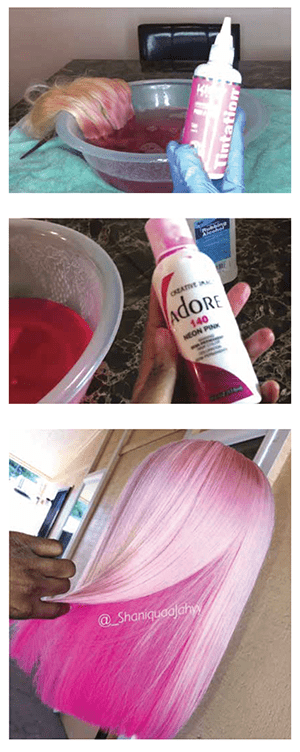
- Grab 613 colored wig and prepare a boiling water. Put KISS color T740 (rose gold) into the water to make a base color for the wig. Deep the wig gradually and slowly from the bottom to top. (This step should take about four minutes.)
- Now you have a base wig. Mix KISS color T441 (pink petal) into the mixture. The color should be close to pastel pink before mixing them. When the second color is completely mixed, deep the entire wig in the mixture for three to four minutes. If you do not have a desired result, you can give it more time.
- By this time, the mixture is cooled down significantly. Bring the water to boil again, add Adore 140 (neon pink), which is a darker pink, and deep the bottom half of the wig for three to four minutes.
- After drying, get it into your style. You should have something like this.
Cover Story BY BNB Magazine
BNB MAGAZINE October 2019 ©bnbmag.com
ABOUT US / SUBSCRIBE / ADVERTISE WITH US / PARTICIPATION / CONTACT /